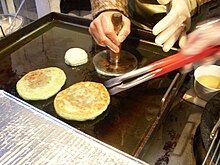
Korean cuisine has evolved through centuries of social and political change. Originating from ancient agricultural and nomadic traditions in Korea and southern Manchuria, Korean cuisine reflects a complex interaction of the natural environment and different cultural trends.

Glutinous rice is a type of rice grown mainly in Southeast East Asia, the northeastern regions of India and Bhutan which has opaque grains, very low amylose content, and is especially sticky when cooked. It is widely consumed across Asia.
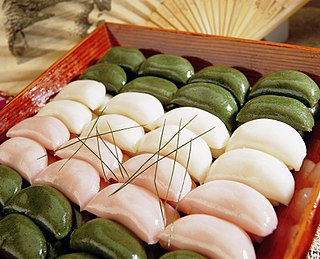
Songpyeon is a traditional Korean food made of rice powder. Its shape resembles a half moon and it is a representative rice cake of Korean holidays and traditional culture. It is a type of tteok, small rice cakes, and variety of fillings are used—some include red bean paste, toasted sesame seeds, and chestnuts. Songpyeon is traditionally eaten during the Korean autumn harvest festival, Chuseok, where it is often prepared by families at home. It is a popular symbol of traditional Korean culture. The earliest records of songpyeon date from the Goryeo period.

Tteok is a general term for Korean rice cakes. They are made with steamed flour of various grains, especially glutinous and non-glutinous rice. Steamed flour can also be pounded, shaped, or pan-fried to make tteok. In some cases, tteok is pounded from cooked grains.

A rice cake may be any kind of food item made from rice that has been shaped, condensed, or otherwise combined into a single object. A wide variety of rice cakes exist in many different cultures in which rice is eaten. Common variations include cakes made with rice flour, those made from ground rice, and those made from whole grains of rice compressed together or combined with some other binding substance.

Rice flour is a form of flour made from finely milled rice. It is distinct from rice starch, which is usually produced by steeping rice in lye. Rice flour is a common substitute for wheat flour. It is also used as a thickening agent in recipes that are refrigerated or frozen since it inhibits liquid separation.
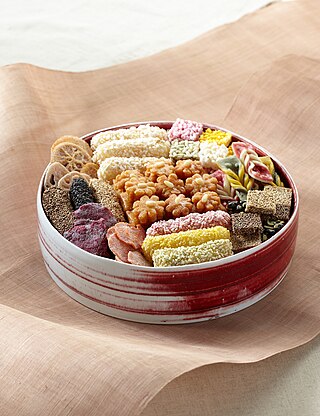
Hangwa is a general term for traditional Korean confections. With tteok, hangwa forms the sweet food category in Korean cuisine. Common ingredients of hangwa include grain flour, fruits and roots, sweet ingredients such as honey and yeot, and spices such as cinnamon and ginger.

Yeot (Korean: 엿) is a variety of hangwa, or Korean traditional confectionery. It can be made in either liquid or solid form, as a syrup, taffy, or candy. Yeot is made from steamed rice, glutinous rice, glutinous sorghum, corn, sweet potatoes, or mixed grains. It is presumed to have been used before the Goryeo period. The steamed ingredients are lightly fermented and boiled in a large pot called a sot for a long time.

Sirutteok (Korean: 시루떡) is a type of Korean rice cake (tteok) traditionally made by steaming rice or glutinous rice flour in a "siru" (시루).
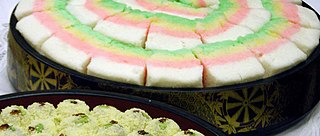
Mujigae-tteok (Korean: 무지개떡) or rainbow rice cake is a layered tteok of different colors resembling a rainbow. It is used for special occasions such as a banquet, party, or feast like doljanchi, hwangapjanchi. Alternative names for mujigae-tteok include saektteok (색떡) and saekpyeon (색편), both of which means "colored rice cakes".
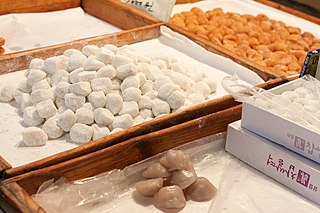
Chapssal-tteok, also called chaltteok, is a tteok, or Korean rice cake, made of glutinous rice.
Korean regional cuisines are characterized by local specialties and distinctive styles within Korean cuisine. The divisions reflected historical boundaries of the provinces where these food and culinary traditions were preserved until modern times.

Betawi cuisine is rich, diverse and eclectic, in part because the Betawi people that create them were composed from numbers of regional immigrants that came from various places in the Indonesian archipelago, as well as Chinese, Indian, Arab, and European traders, visitors and immigrants that were attracted to the port city of Batavia since centuries ago.
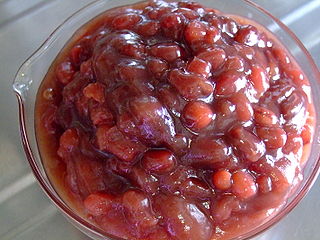
Red bean paste or red bean jam, also called adzuki bean paste or anko, is a paste made of red beans, used in East Asian cuisine. The paste is prepared by boiling the beans, then mashing or grinding them. At this stage, the paste can be sweetened or left as it is. The color of the paste is usually dark red, which comes from the husk of the beans. In Korean cuisine, the adzuki beans can also be husked prior to cooking, resulting in a white paste. It is also possible to remove the husk by sieving after cooking, but before sweetening, resulting in a red paste that is smoother and more homogeneous.
